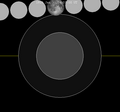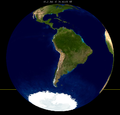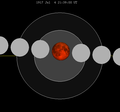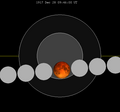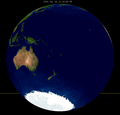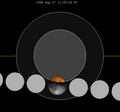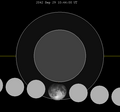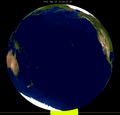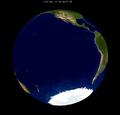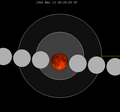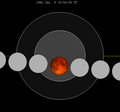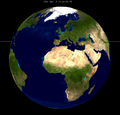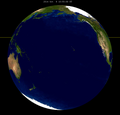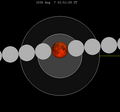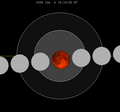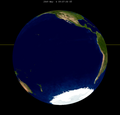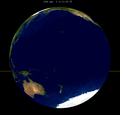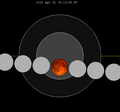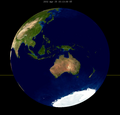Top Qs
Timeline
Chat
Perspective
July 1916 lunar eclipse
Partial lunar eclipse in 1916 From Wikipedia, the free encyclopedia
Remove ads
A partial lunar eclipse occurred at the Moon’s ascending node of orbit on Saturday, July 15, 1916,[1] with an umbral magnitude of 0.7944. A lunar eclipse occurs when the Moon moves into the Earth's shadow, causing the Moon to be darkened. A partial lunar eclipse occurs when one part of the Moon is in the Earth's umbra, while the other part is in the Earth's penumbra. Unlike a solar eclipse, which can only be viewed from a relatively small area of the world, a lunar eclipse may be viewed from anywhere on the night side of Earth. Occurring only about 3.5 hours after perigee (on July 15, 1916, at 1:15 UTC), the Moon's apparent diameter was larger.[2]
Remove ads
Observations
Summarize
Perspective
The Ross Sea party was a component of Sir Ernest Shackleton's Imperial Trans-Antarctic Expedition of 1914–17. Five men were stranded not far away from Cape Evans. There was sea ice between them and the relative safety of the hut on Cape Evans. On May 8 two of the men, Aeneas Mackintosh and Victor Hayward, decided to make an attempt to reach the hut. Soon after they set out, a blizzard hit. When the weather cleared up, the remaining men tried to look for them, but realized that the ice was far too thin to cross, and that their friends had been lost. Now they knew that they should wait for a thicker ice and for the full moon to attempt the crossing. Having the full moon was essential, because during polar night the moon is the only source of natural light other than the extremely dim light of the stars.
The weather did not cooperate during the full moon of June, but on July 15, everything seemed to be just right: calm weather, thick ice, clear skies and a full moon. The men started their journey in the morning. When the moon rose, however, the men were surprised to find it was about to be eclipsed[citation needed]. Ernest Wild wrote later:
"I thought we were going to be left in darkness but a very little bit of the rim remained to light us..."
Although the eclipse continued for a few hours, the men were fortunate because it was only a partial eclipse. They reached Cape Evans later on the same day.[3]
Remove ads
Visibility
The eclipse was completely visible over eastern North America, South America, and Antarctica, seen rising over western North America and the central Pacific Ocean and setting over Africa and western Europe.[4]
  |
Eclipse details
Shown below is a table displaying details about this particular solar eclipse. It describes various parameters pertaining to this eclipse.[5]
Eclipse season
This eclipse is part of an eclipse season, a period, roughly every six months, when eclipses occur. Only two (or occasionally three) eclipse seasons occur each year, and each season lasts about 35 days and repeats just short of six months (173 days) later; thus two full eclipse seasons always occur each year. Either two or three eclipses happen each eclipse season. In the sequence below, each eclipse is separated by a fortnight.
Remove ads
Related eclipses
Summarize
Perspective
Eclipses in 1916
- A partial lunar eclipse on January 20.
- A total solar eclipse on February 3.
- A partial lunar eclipse on July 15.
- An annular solar eclipse on July 30.
- A partial solar eclipse on December 24.
Metonic
- Preceded by: Lunar eclipse of September 26, 1912
- Followed by: Lunar eclipse of May 3, 1920
Tzolkinex
- Preceded by: Lunar eclipse of June 4, 1909
- Followed by: Lunar eclipse of August 26, 1923
Half-Saros
- Preceded by: Solar eclipse of July 10, 1907
- Followed by: Solar eclipse of July 20, 1925
Tritos
- Preceded by: Lunar eclipse of August 15, 1905
- Followed by: Lunar eclipse of June 15, 1927
Lunar Saros 118
- Preceded by: Lunar eclipse of July 3, 1898
- Followed by: Lunar eclipse of July 26, 1934
Inex
- Preceded by: Lunar eclipse of August 3, 1887
- Followed by: Lunar eclipse of June 25, 1945
Triad
- Preceded by: Lunar eclipse of September 13, 1829
- Followed by: Lunar eclipse of May 16, 2003
Lunar eclipses of 1915–1918
This eclipse is a member of a semester series. An eclipse in a semester series of lunar eclipses repeats approximately every 177 days and 4 hours (a semester) at alternating nodes of the Moon's orbit.[6]
The penumbral lunar eclipses on March 1, 1915 and August 24, 1915 occur in the previous lunar year eclipse set.
Saros 118
This eclipse is a part of Saros series 118, repeating every 18 years, 11 days, and containing 73 events. The series started with a penumbral lunar eclipse on March 2, 1105. It contains partial eclipses from June 8, 1267 through August 12, 1375; total eclipses from August 22, 1393 through June 22, 1880; and a second set of partial eclipses from July 3, 1898 through September 18, 2024. The series ends at member 73 as a penumbral eclipse on May 7, 2403.
The longest duration of totality was produced by member 37 at 99 minutes, 22 seconds on April 7, 1754. All eclipses in this series occur at the Moon’s ascending node of orbit.[7]
Eclipses are tabulated in three columns; every third eclipse in the same column is one exeligmos apart, so they all cast shadows over approximately the same parts of the Earth.
Tritos series
This eclipse is a part of a tritos cycle, repeating at alternating nodes every 135 synodic months (≈ 3986.63 days, or 11 years minus 1 month). Their appearance and longitude are irregular due to a lack of synchronization with the anomalistic month (period of perigee), but groupings of 3 tritos cycles (≈ 33 years minus 3 months) come close (≈ 434.044 anomalistic months), so eclipses are similar in these groupings.
Inex series
This eclipse is a part of the long period inex cycle, repeating at alternating nodes, every 358 synodic months (≈ 10,571.95 days, or 29 years minus 20 days). Their appearance and longitude are irregular due to a lack of synchronization with the anomalistic month (period of perigee). However, groupings of 3 inex cycles (≈ 87 years minus 2 months) comes close (≈ 1,151.02 anomalistic months), so eclipses are similar in these groupings.
Half-Saros cycle
A lunar eclipse will be preceded and followed by solar eclipses by 9 years and 5.5 days (a half saros).[9] This lunar eclipse is related to two annular solar eclipses of Solar Saros 125.
| July 10, 1907 | July 20, 1925 |
|---|---|
 |
 |
Remove ads
See also
Notes
References
External links
Wikiwand - on
Seamless Wikipedia browsing. On steroids.
Remove ads




